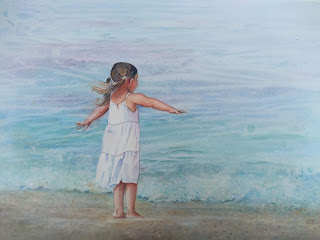"Maddie by the Sea" on Arches

"Maddie by the Sea" on watercolor canvas
There are times when you want the look of canvas, and it can be done in watercolor. There are 4 popular options:
1. Fredrix watercolor canvas, stretched
2. Fredrix watercolor canvas, on board
3. Watercolor canvas in pads
4. Regular canvas covered with 2-3 layers of Ground
I am covering their advantages/disadvantage one by one. (Prices are Dick Blick)
1. Pre-purchased watercolor canvas, stretched.
One 9 x 12 is $19.60
Advantage: It is ready to paint on, no waiting for product to dry.
You can buy a cheaper Masters Touch brand at Hobby Lobby.
2. Watercolor canvas board.
Advantage: Ready to paint on, no waiting for product to dry.
One 9 x 12 is $ 8.65
3. Canvas pads
10 sheets of 9 x 12 is $14.10.
You can NOT just paint on one of these sheets until it is securely mounted on board or other hard surface. It will just curl and be impossible to work with.
I use YES paste to glue it to a strong surface, such as heavy mat board or the leftover board from a block of paper. You can also use extra heavy matte Gel. Regular glue will not be strong enough. I have also used a strong spray adhesive that works very well, for about $5 a can. Purchased at Wal-Mart in craft department.Disadvantage: You have to wait for this to dry for a few hours before painting.
Advantage: Cost and only a short wait before painting
By the time you purchase the glue (about $20 for a jar that will do about 15) you have about $35 to make 10 9x12's, or $3.50 each. Plus whatever you spend for the board to mount it on.
You can also purchase this canvas on rolls, which you can stretch or mount yourself. A roll of 58" by 3 yards is $82.60. But I really don't think I would use all that in my lifetime.
4. Making your own canvas board with canvas board and ground.
Cost of 10 9x12 regular canvas: $15
Cost of enough ground to cover the canvas 3 times: $18 (ground is available from Daniel Smith, QoR, Schmincke, and others. Holbein calls theirs watercolor texture paste. Schmincke calls theirs primer.)
Total cost for 10: $33. $3.30 a piece.
Advantage: cost; can create textures; ready availability of regular canvas
Disadvantage: you have to wait 48-72 hours before painting on this surface. It is also more time-consuming than the others.
Transferring the sketch to canvas
You can't use your trusty light box to transfer the picture onto canvas because it is too opaque. You can use Saral, which is is a graphite paper that you put between the drawing and the canvas, then trace it. Or you can also just draw it, if you are confident. Try not to erase.
This is a rougher surface than paper, and erasures may end up smudged. If you need to erase, use a Mr. Clean magic eraser, dampened.
Painting Process on Canvas
The process of painting on canvas can be a lot different than paper. It is hard to glaze one color over another because the paint tends to lift easier. It isn't as out of control as yupo, but you do have to be careful to paint it the value you want first.
Learning to blend on it is harder at first. You can still do wet on wet or wet on dry. You can still use certain techniques, such as Saran wrap and some textures. Painting tiny details is hampered by the texture.
The advantage is that the paint lifts easily without making the surface look worn. Paint looks very vibrant and clean. No mounting or matting needed. Just pop into frame.
Finishing the Painting
I like to frame the canvases without mat or glass. To do that, I have to use a finishing product, such as Kamar varnish (a non-yellowing archival varnish made for watercolor).
Each type of canvas will have it's own degree of texture. Some are smoother than others.
Here are some excellent video references for watercolor canvas:
Mind of Watercolor explains watercolor canvas--about 15 min
https://www.youtube.com/watch?v=0UZ_lABXDAw
Liz Chaderton gives best tips
https://www.youtube.com/watch?v=uf1yuYyTfSs
don't expect canvas to act like paper
prepare with watercolor ground
plan--there's no way to hide, no place to cut
paint flat
don't use your best brushes on canvas
don't use too much pencil when sketching--hard to get rid of
use a magic eraser instead (wet)
be direct and get what you want the first time
don't be afraid of the water
use a spray bottle to move the paint
don't fiddle
do use textures if you want (salt, etc)
do control the water
do let it dry
stand up to paint
do be patient - takes longer than paper to dry
lift out mistakes easily
use small brush with controlled amt of water to glaze
seal and protect
varnish or Dorlands wax
30 tips from Liz Chaderton (20 min)
https://www.youtube.com/watch?v=xLAMi9mNf1U
How to prepare a canvas (6 minutes)
https://www.youtube.com/watch?v=j7yYyIrTESA&t=0s

































